You should consider installing heat pump risers to help your unit live longer, run quieter, and more efficiently during deep snowfall.
Risers allow the units to drain and help to reduce some vibration. Heat risers also called pump snow legs should be tall enough to keep a heat pump above average snowfall.
What is A Heat Pump Snow Leg?
Snow legs, risers, or pump ups, they are the same. You can even make a frame of angle iron or buy the more common plastic risers. I’ve even seen units raised up on bricks or blocks. That doesn’t look as cool or reduce any vibrations.
This site contains affiliate links. If you purchase on these links, you don’t pay more, but I get a small commission.
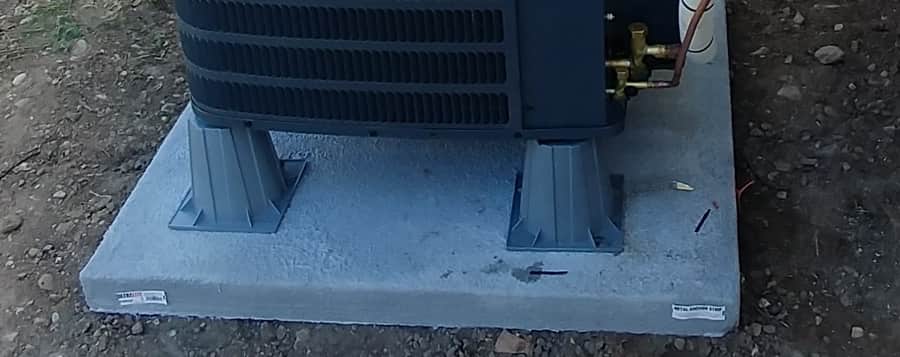
Literally hidden from sight and unknown to 99% of all homeowners are the tiny drain holes at the bottom of your outdoor unit.
When your outdoor unit is installed directly on the pad, those tiny drain holes become even smaller and less likely to drain.
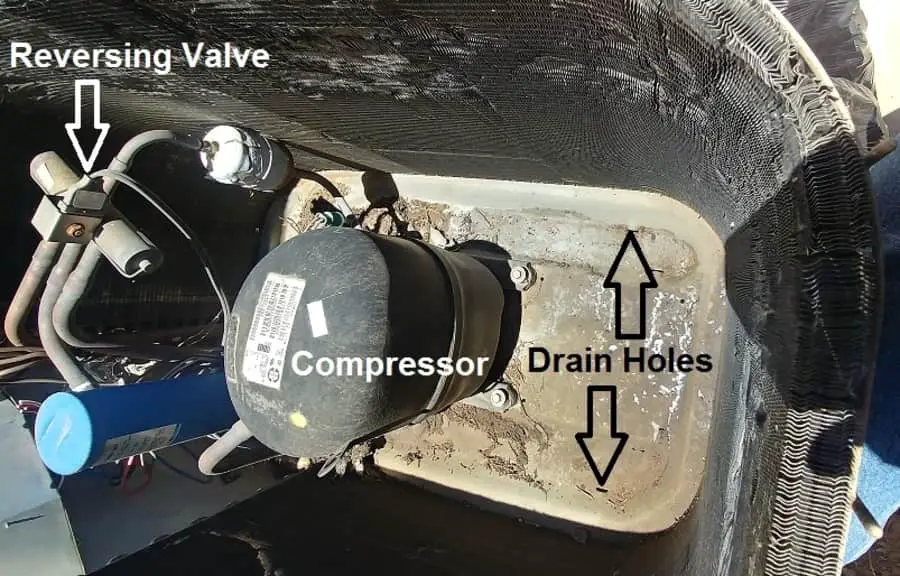
Especially if the inside of your unit is full of rotting leaves or other debris that seems to fall into these units because they have a big hole in their top lid.
The end result is an early death for the unit, Not tomorrow, but sooner than if the installation were done properly. Air conditioners can benefit from being raised slightly above the pad, but heat pumps need that lift to drain during their winter defrost cycles.
You have to realize that when a heat pump is cooling your home in summer, the cold coil is the coil at the furnace. When that heat pump is heating your home in winter, that cold coil is the coil in the outdoor unit.
The outdoor ambient is pulled through that coil, and the air temperature across that coil is approximately 15 degrees. Just put your hand over the top when it is in heat mode. When those outdoor temperatures drop, that can cause an outdoor coil to ice up.
Defrost cycles occur during the winter operation of heat pumps. You may have noticed if you have a heat pump that when outdoor temperatures get down and somewhat below the 40-degree Fahrenheit range, the outdoor coils begin to develop frost on the surface of the coils.
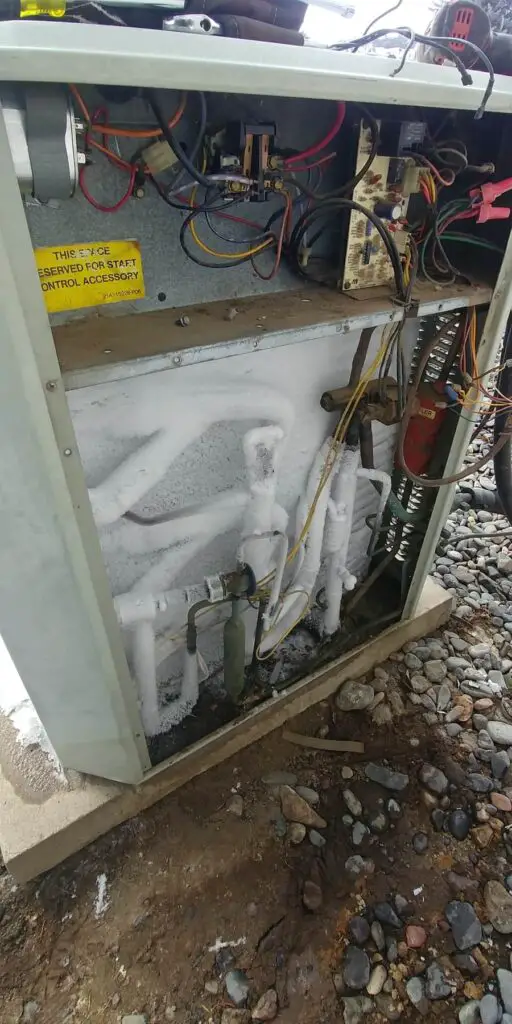
If the defrost control is not timing the defrost correctly like the unit above, or the sensors have failed, that frost will develop into a block of ice. Other things can contribute to ice forming at the bottom of an outdoor unit, such as a low or improper refrigerant charge.
Expected snow level is a great indicator of how high a heat pump should be raised above it’s pad. These heat pump riser legs are fixed at 6 inches. Although you can buy different heights through suppliers like Amazon.
The fan inside your outdoor heat pump is meant to move air through the coils. The coils are the aluminum finned part of the unit that surrounds the outside from top to bottom. Sometimes covered by a louvered steel surround, you have to get up close to see the coil behind.
In harsh winter conditions, snow and ice can accumulate up over the bottom of the unit and begin to block the air flow. Raising the unit up over what snow level that may fall on average in your area. During those 100 year snow falls you need to get out and shovel it away.
Don’t rely on the fact that everytime the unit goes into defrost that it will melt away the snow. That snow becomes ice in a deep enough freeze. You can use warm water to get rid of what gets ahead of your snow and ice removal. Even water from your hose should be warm enough to do some melting.
Never use in tools to break away the ice if it does thicken and cover your unit. Those coils are fragile and you can puncture the copper tubing and create an extremely expensive service call to say the least. Now your on emergency heat and your electric meter is spinning out of control.
If you want to know how to defrost your heat pump in winter, click the link and read one of my articles that covers that defrost issue.
How Much Ice Is Too Much Ice On A Heat Pump?
When galvanized and copper pipes freeze, the freezing water inside the pipe expands and can burst the pipe. The potential for leaks is much less with PEX tubing because it has the ability to expand when freezing and will be less likely to break and leak, but it can.
So it’s not water inside the refrigeration pipe of a heat pumps coil, it’s Freon, then what’s freezing pipes got to do with a heat pump. Ice is a very powerful force. Not only will it burst water pipes from the inside, but it will crush refrigeration pipes from the outside.

When ice forms around these copper refrigeration lines it has no where to go but to crush the copper tubing and restrict the flow of refrigerant inside the line. As you can see by the image above it also has destroyed the aluminum fins around the tubing.
The end result is often that leaks form in the copper and all Freon is lost to the atmosphere.
How To Install Heat Pump Risers And Pad
It’s a whole lot easier to install a new level pad with snow legs at the time of the original installation. But, it can be done after the fact.
It’s a one man do it yourself project. Their are some precautions. When adding pad and risers to an existing heat pump, extreme care needs to be taken not to create a leak at the refrigeration lines that enter the house from the unit.
If those lines are a couple feet long or more you have a good chance. Best to get a service tech to give you an opinion or even hire one to get it done.
But like I said it can be done and it’s not a huge project if done the right way. I gathered up a couple of 2 by’s and some blocks. With a little patience and some ingenuity you can make your heat pump last a few more years.
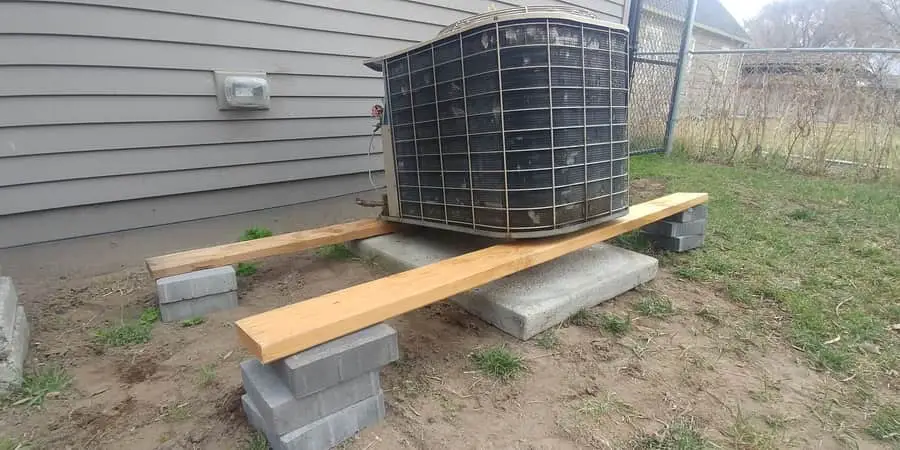
Place the lumber under the unit first. Raising it slightly, just a little bit at a time. Continue to go around the unit with blocks going up one block at time while keeping an eye on that refrigeration line that it doesn’t brake. Copper is fairly flexible. Just be careful.
Using 2X4’s that are long enough to give some leverage.
Level and replace a pad and add risers. Shorter risers will do if you don’t think you can get it high enough.
Additional Benefits Of Having Your Heat Pump Or Air Conditioner Elevated
The one thing I really like about these plastic pump ups is the little pieces of tar like material stuck to the top and bottom of the risers. It gives the unit a solid footing to the pad and quiets down any vibrations.
Looking at a unit raised about 6 inches, you would think it would be a little shaky, but they end up quite stable as long as the pad is firm to the ground.
It’s a very little thing, but when you consider the alternative of setting a unit directly on that gritty pad it’s a great advantage for units set near neighbors windows or your own window and living areas.
When the freezing weather comes you can be sure that the water is draining away much better that it would if allowed to gather around the bottom of your unit.
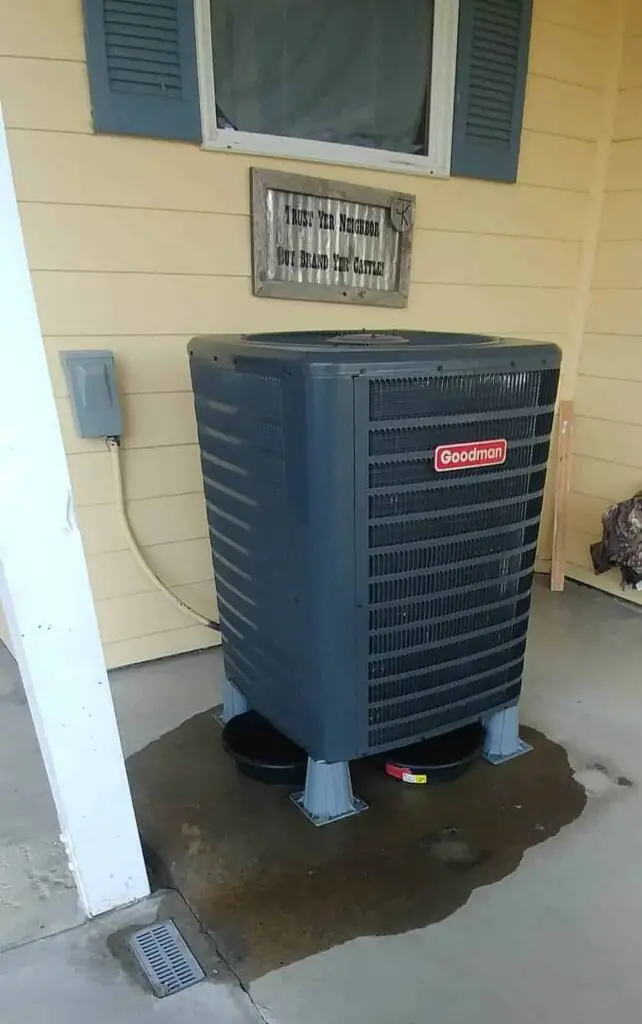
My customer who owns the heat pump in the image above likes to capture the water in small pans. Don’t know if I can agree with that process, but it makes him happy. Hard to beat a happy customer, who by the way is always right. And if he’s not right, he’s still my customer.
I like putting air conditioners on 3″ risers. Like I said it dampens the noise and helps keep the unit clean. You can hose off under the unit and it’s not sitting down on that scratchy pad and turning to rust prematurely.
You might think it’s just an air conditioner with a metal base and what would it hurt to just set it right on the pad. If you would have removed as many of these units as I have and looked at the rust at the base because the water never was able to dry out between the base of the unit and the pad, then you’d choose to use risers.
